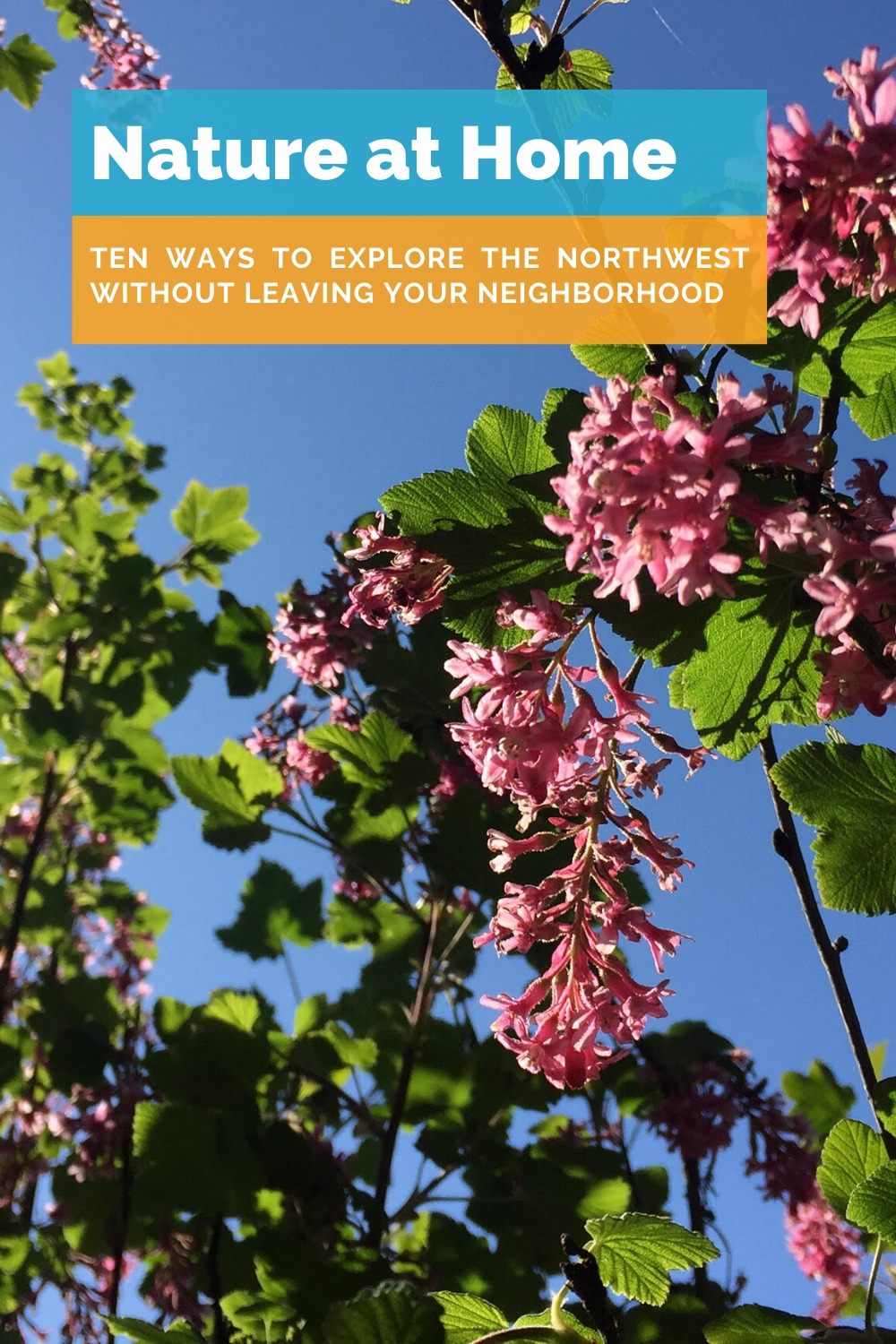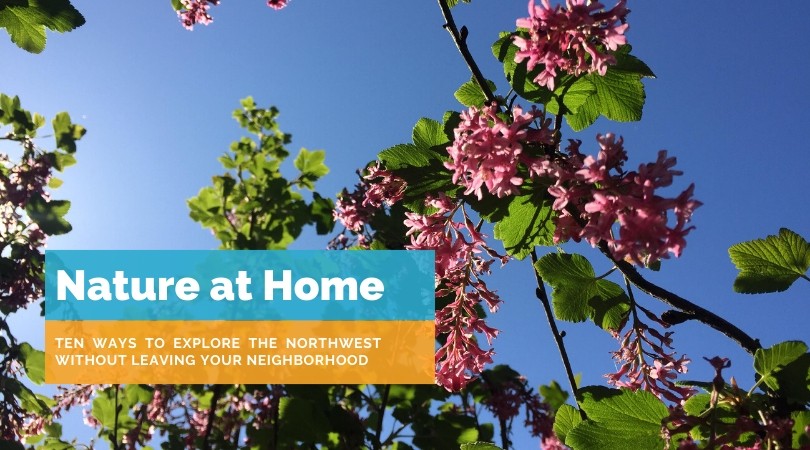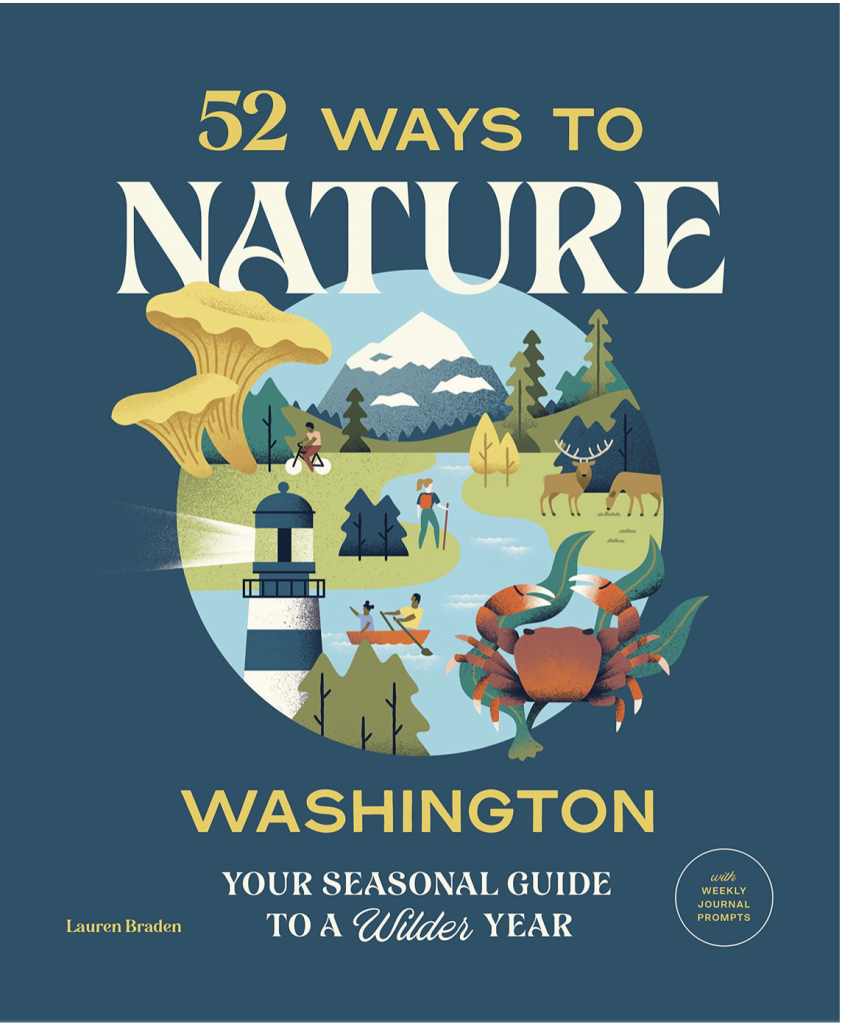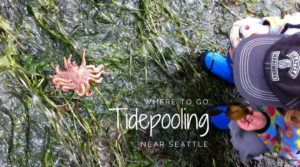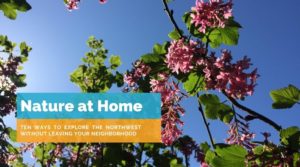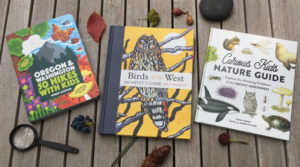It’s not overstating things to say we are living through a really weird time right now. All of us, in different ways, are spending our days in ways we were not just a month ago. If you’re a front-line health care worker you’re risking your own wellness every day to save lives of people afflicted by the novel coronavirus. If you’re a kid, you’re probably playing the new Animal Crossing when you’d otherwise be sitting in a classroom. If you’re me, sitting here thinking about what to write about, because you can’t write about the Skagit tulips, or the migrating whales, or the desert hikes that are just starting their bloom, or the sandhill cranes.
Spring adventure in the Pacific Northwest has been cancelled. And yet the red-flowering current is in full bloom, right outside my bedroom window. It’s been found by the busy bushtits, searching the branches for tiny insects to gobble up, and the bumblebees who come in small swarms for its nectar. Unlike us, the bushtits and bumblebees don’t know about the virus.
Spring continues all around us, right outside our doors and windows for us to enjoy, if only we take the time to look, and listen, and smell, and learn.
![]() COVID-19: Which Northwest Public Lands are Re-Opening | COVID-19: The Perfect Guidebook for Finding Trails Close to Your Home
COVID-19: Which Northwest Public Lands are Re-Opening | COVID-19: The Perfect Guidebook for Finding Trails Close to Your Home
I’ve created list of unique ways we can stay connected to nature through the rest of our time staying at home to limit spread of Covid-19, which for many of us is going to extend into June. I started this list for my family a few weeks ago, and I’ve expanded it a bit here to share with you. I hope you enjoy it and discover some new ways to keep nature in your life in this time of social distancing, even from a window or your backyard!
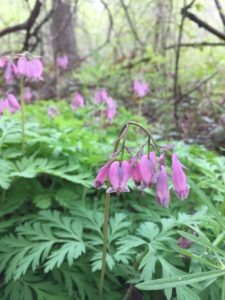 Start your day with nature, right where you are. In the morning, as soon as you wake up, open a window or walk out into your yard. Open your eyes and ears, letting the sights and sounds in. Notice the sunrise, and try to name every hue. Look to see if the buds on tree branches are bigger than they were yesterday, or if new flowers are in bloom. Are there insects buzzing? Do you hear birds singing? American Robins deliver their quick, cheery succession of whistling notes very early on spring mornings, often before 6am. Male chickadees serenade the dawn with a mournful 2-3 note whistle. Look, listen, and breathe.
Start your day with nature, right where you are. In the morning, as soon as you wake up, open a window or walk out into your yard. Open your eyes and ears, letting the sights and sounds in. Notice the sunrise, and try to name every hue. Look to see if the buds on tree branches are bigger than they were yesterday, or if new flowers are in bloom. Are there insects buzzing? Do you hear birds singing? American Robins deliver their quick, cheery succession of whistling notes very early on spring mornings, often before 6am. Male chickadees serenade the dawn with a mournful 2-3 note whistle. Look, listen, and breathe.
Make a list of the birds that visit your yard. Don’t worry if you don’t have binoculars or a bird guidebook, you won’t need them for this. Do this over the course of one day or several days. Grab a pad of paper and write down every bird you see in your yard. Try to identify each mystery bird using an online bird guide like Seattle Audubon’s Birdweb or Cornell’s All About Birds. When you spot a bird, spend some time observing its behavior. Is it alone, with a mate, or in a flock with other birds? It the bird on the ground, hopping along a fence, or perched still on a tree branch? Does it appear to be foraging for little bugs on a tree limb like a chickadee, or hunting for seeds on the ground like a junco? You might see birds like jays and robins every day, but once you take a little time to observe their unique behaviors and see their special place in the local ecosystem, you’ll never look at them as ordinary birds again. Some common birds of spring you might expect to see in your yard in the Pacific Northwest include American Robin, Black-Capped Chickadee, Stellar’s Jay, Northern Flicker, American Goldfinch, House Finch, Bewick’s Wren, and Bushtit, just to name a few. If you want to have your own bird guide, I recommend the Sibley Guide for Western birds.
Look at the moon every night. It’s a grounding experience in turbulent times to keep watch on the moon and remember that it is still turning, and so are we. Notice as it changes over a month from a full moon to a waning gibbous to a new moon to a waxing crescent. Stardate has a moon phase calendar.
Go stargazing. As spring lurches towards summer, our Northwest skies become more clear. One small bonus with stay-at-home orders? There may be a little less light pollution in urban areas with fewer buildings lit up and cars on the road. You won’t see the whole milky way from Bellevue, but you might be able to make out some constellations. Head outside after sundown and use a stargazing app that displays stars, planets and constellations as you point your phone around the night sky. First, find the Big Dipper. Many constellations can be located from the Big Dipper, including Ursa Major (the Great Bear) which the Big Dipper is a part of. From here, locate the Little Dipper; Polaris (the North Star) is the last star of its handle. From here you can start to make out other constellations like Cassiopeia, Cepheus and Draco.
Track critters through your neighborhood. On your next walk, look for signs that wildlife were present, as they often leave clues behind, from hidden homes to footprints in the dust. Drilled holes in a neat pattern on tree trunks mean a sapsucker was there for a sweet meal. At your feet, small round droppings of scat may tell you a cottontail rabbit was in the area. Look for regurgitated pellets at the base of trees where the owls might roost—these are made of the indigestible parts of their prey like fur and bones. A hole in the ground might be a chipmunk’s house. A blue and black feather in the grass probably belonged to a Stellar’s Jay. This pocket naturalist guide to animal tracking will help you on your tracking adventures.
Take a foraging stroll. Dandelions are pesky weeds, but their leaves are remarkably tasty, especially before the flowers open. Have a Douglas Fir tree in your neighborhood? The spring green tips can be steeped in boiling water to make a slightly minty and earthy tea. Urban parks and walkways contain lots of edible plants you can forage, from nettles to blackberries, but it’s important to identify plants carefully and avoid areas that could be sprayed with pesticides to stay safe. This pocket guide to wild edible plants will get you started, and you’ll find online guides as well.
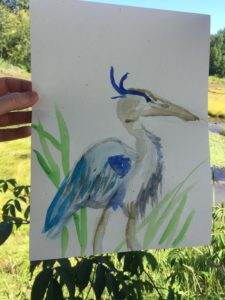 Start sketching. Grab some paper and a pencil, then get outside and find a comfortable place to sit for awhile. Look around for something to sketch. It could be a cat scaling the top of a fence, or a crow poking around the ground for nesting material. Use several tentative strokes to create a loose sketch of your subject, avoiding a solid unbroken line. This technique helps create energy and gives a sense of movement and life to your critter on the page. If you have watercolors, fill in your line sketch with muted hues, and paint in the background. If you enjoy sketching or watercolors in nature, you’ll love Molly Hashimoto’s books.
Start sketching. Grab some paper and a pencil, then get outside and find a comfortable place to sit for awhile. Look around for something to sketch. It could be a cat scaling the top of a fence, or a crow poking around the ground for nesting material. Use several tentative strokes to create a loose sketch of your subject, avoiding a solid unbroken line. This technique helps create energy and gives a sense of movement and life to your critter on the page. If you have watercolors, fill in your line sketch with muted hues, and paint in the background. If you enjoy sketching or watercolors in nature, you’ll love Molly Hashimoto’s books.
Keep a nature journal. Any notebook will do. I’m particularly fond of the Moleskine classic notebook. Record signs of spring in nature that you see, hear, smell in your yard or on a walk around your neighborhood. Note when the cherry blossoms bloom, or the date you first spot a tulip opening its petals. You might observe chickadees building a nest in a tree cavity, or hear the high-pitched pipes of a bald eagle overhead. As you start to record your observations in nature on a regular basis, you’ll probably find you notice so much more when outdoors—it’ll seem as if someone turned nature’s volume up.
 Learn how to use a topographic map and compass. Every hiker knows that a map and compass are part of the “ten essentials,” but have you ever actually used one for navigation in the backcountry? Practice locating landmarks on your topo map, getting your bearings, finding true north, and more. Find and print (or download) a free topo map for your neighborhood with the USGS right here. Then, grab your compass and follow along with this informative, step-by-step video lesson from REI on using a map and compass, and you’ll be on your way to becoming a navigation ninja.
Learn how to use a topographic map and compass. Every hiker knows that a map and compass are part of the “ten essentials,” but have you ever actually used one for navigation in the backcountry? Practice locating landmarks on your topo map, getting your bearings, finding true north, and more. Find and print (or download) a free topo map for your neighborhood with the USGS right here. Then, grab your compass and follow along with this informative, step-by-step video lesson from REI on using a map and compass, and you’ll be on your way to becoming a navigation ninja.
Read your guidebooks and dream of future hikes. Do you pull out your hiking guidebooks on Friday nights just to flip through and choose a last-minute hike for the weekend? That’s a great use for them, but many guidebooks are wonderful to read when curled up in a comfy chair with a cup of tea. I’m particularly fond of reading the old Spring / Manning hiking guidebooks published by the Mountaineers Books. I like to keep tape flags nearby to bookmark trails I want to try over the next year. If you’re looking for a great guidebook to read and plan your future hikes when the trails open up again, I recommend 100 Classic Hikes of Washington by Craig Romano, or 100 Classic Hikes in Oregon by Douglas Lorain.
Here are Ten MORE Ideas for Getting Nature Into Your Quarantine Life
- Take your shoes off and feel the soft grass under your feet.
- Download the iNaturalist app for your phone and record your observations.
- Sit perfectly still in your yard for ten minutes. That about how long it takes for critters and birds to no longer notice you, creating a good opportunity for birds to come in closer to where you are.
- Walk around your neighborhood and find a plant or flower in every color of the rainbow: red, orange, yellow, green, blue, violet.
- Find a four-leaf clover.
- When it rains, go outside and don’t bring an umbrella. Feel it on your face, and breathe in deeply to smell the rain as it mingles with the thirsty earth.
- Look for bugs. Count how many different insects, spiders or worms you can see on a walk around your neighborhood. It helps to bring a magnifying glass. Search for ants, bees, dragonflies, ladybugs, pill-bugs and butterflies.
- Sit in your yard on a partly-cloudy day and look up. Find different shapes in the clouds, just as you did as a child.
- Fly a kite. It is the ultimate social-distancing past-time, as you need lots of space around you to safely get a kite in the air!
- Pitch your tent and go “camping” in your backyard.
- Try to identify all the trees in the front yards on your block, from the cherry trees to the conifers.
Stay safe, be well and enjoy nature wherever you are!
